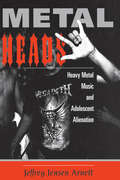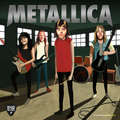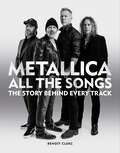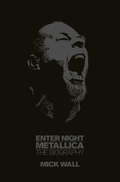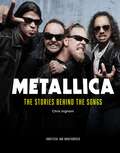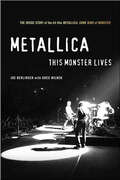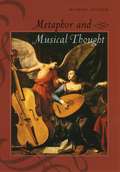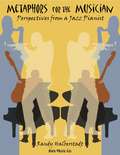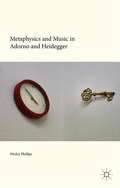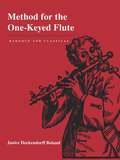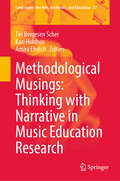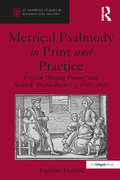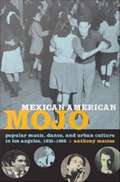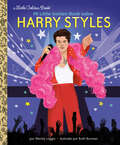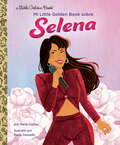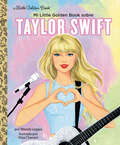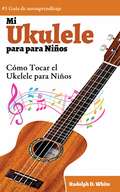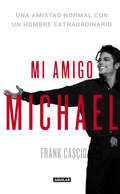- Table View
- List View
Metalheads: Heavy Metal Music and Adolescent Alienation
by Jeffrey Arnett<p>Heavy metal is a violent, head-bashing music complete, in its live performances, with its own arena of rage and celebration, the mosh pit. It is a music in the red corner of society, loud, angry, and, to a well-tuned ear, practically intolerable. And yet, the art form radiates a message about American adolescents well worth examining and comprehending: Its devotees, primarily adolescent boys, are alienated from their world and angry about its future. <p>Heavy metal speaks throbbingly the message of rage, loneliness, and cynicism.In this sensitive book, Jeffrey Jensen Arnett synthesizes the stories and experiences of seventy male and thirty-eight female “metalheads” in a successful attempt to understand the often crippling results of a society and an image of the nuclear family steeped in conformity, self-denial, and obedience. The vacuum such an atmosphere creates in the individual can be temporarily obliterated by a heavy metal concert, which Arnett sees as a substitute manhood ritual. This conclusion is just one of the many striking hypotheses the author advances in this dynamic study of a music and its followers. <p>Of the one hundred metalheads interviewed for this volume, ten have allowed themselves to be profiled in depth—the reader becomes fully acquainted with Jack, for instance, and with the multiple crosses decorating his body, his black rose tattoo, and his tumultuous family life; or with slim and well-groomed Jean dressed entirely in black, her favorite color, and wearing the temperament of withdrawal. This is a unique study filled with compassion for a disenfranchised subculture and the respect to want to understand it.</p>
Metallica (Band Records #2)
by Soledad Romero Mariño David NavasLa historia de METALLICA, el legendario grupo de Thrash Metal, explicada a los más pequeños. La fascinante historia de Metallica empieza en Los Ángeles, cuando Lars Ulrich, una promesa del tenis mundial, abandona su carrera para montar una banda Metal y convertirse en el mejor baterista del mundo. Cuando puso un anuncio en una revista para encontrar compañeros de banda interesados en los sonidos de Motorhëad e Iron Maiden, apareció James Hetfield, guitarrista y cantante con alguna experiencia en otros grupos. Al poco se les unieron Dave Mustain y Cliff Burton para completar la formación y conquistar el feroz mundo del Metal. Metallica es un cuento que derrocha los valores que el Rock ha dejado a toda una generación: libertad, coraje, independencia y lealtad a uno mismo.
Metallica (Band Records #Volumen)
by David Navas Soledad Romero MariñoLa historia de METALLICA, el legendario grupo de Thrash Metal, explicada a los más pequeños. La fascinante historia de Metallica empieza en Los Ángeles, cuando Lars Ulrich, una promesa del tenis mundial, abandona su carrera para montar una banda Metal y convertirse en el mejor baterista del mundo. Cuando puso un anuncio en una revista para encontrar compañeros de banda interesados en los sonidos de Motorhëad e Iron Maiden, apareció James Hetfield, guitarrista y cantante con alguna experiencia en otros grupos. Al poco se les unieron Dave Mustain y Cliff Burton para completar la formación y conquistar el feroz mundo del Metal. Metallica es un cuento que derrocha los valores que el Rock ha dejado a toda una generación: libertad, coraje, independencia y lealtad a uno mismo.
Metallica All the Songs
by Benoît ClercThis is the most in-depth exploration of Metallica's songs ever written.From their widely circulated demo, No Life 'til Leather, all the way to their 10th studio album Hardwired... to Self-Destruct - Metallica have earned the title of the biggest heavy metal band on the planet. Their albums, including the hugely influential Master of Puppets, are now considered classics of rock and metal, while singles such as Enter Sandman, Fade to Black and For Whom the Bell Tolls have stood the test of time. Follow the epic journey of the godfathers of thrash metal, song-by-song, and see how they became one of the biggest selling bands in the world.No stone is left unturned across more than 500 pages, illustrated with incredible photography throughout, from the inspiration behind the lyrics and melodies to the recording process and even the musicians and producers who worked on each track.Uncover the stories behind the music in this truly definitive book - a must-have for every Metallica fan.
Metallica All the Songs
by Benoît ClercThis is the most in-depth exploration of Metallica's songs ever written.From their widely circulated demo, No Life 'til Leather, all the way to their 10th studio album Hardwired... to Self-Destruct - Metallica have earned the title of the biggest heavy metal band on the planet. Their albums, including the hugely influential Master of Puppets, are now considered classics of rock and metal, while singles such as Enter Sandman, Fade to Black and For Whom the Bell Tolls have stood the test of time. Follow the epic journey of the godfathers of thrash metal, song-by-song, and see how they became one of the biggest selling bands in the world.No stone is left unturned across more than 500 pages, illustrated with incredible photography throughout, from the inspiration behind the lyrics and melodies to the recording process and even the musicians and producers who worked on each track.Uncover the stories behind the music in this truly definitive book - a must-have for every Metallica fan.
Metallica: The Biography
by Mick Wall'A flaming juggernaut of heavy-metal biog' GUARDIAN'This is the definitive account of heavy metal's biggest band of all' CLASSIC ROCK 'Truly enlightening' ROCK SOUND'ENTER NIGHT, Mick Wall's biography of Metallica confirms this grizzled veteran to be as engaged and waspishly authoritative a chronicler of metal's most hirsute behemoths as Barry Miles has been for the Beats' INDEPENDENT ON SUNDAYMick Wall moves on from Led Zeppelin to produce a definitive doorstop on Metallica.Alongside contemporaries Slayer, Megadeath and Anthrax, Metallica came to prominence in the eighties as one of the 'big four' of thrash metal. Metallica were to thrash, though, what the Sex Pistols were to punk. Nearly thirty years on, their tale is one of alcohol, rule breaking and tragically early death. But allied to that are colossal sales figures for their records -- they are the fifth-highest selling recording artists of all time - and members with backgrounds that touch on jazz and classical music. Metallica, in fact, have garnered more critical acclaim than any heavy rock band since Led Zeppelin. Fresh from the critical and commercial success of WHEN GIANTS WALKED THE EARTH, Mick Wall takes a similar informed look at the band, a group he has known on and off since their formation in 1981.
Metallica: The Biography
by Mick Wall'A flaming juggernaut of heavy-metal biog' GUARDIAN'This is the definitive account of heavy metal's biggest band of all' CLASSIC ROCK 'Truly enlightening' ROCK SOUND'ENTER NIGHT, Mick Wall's biography of Metallica confirms this grizzled veteran to be as engaged and waspishly authoritative a chronicler of metal's most hirsute behemoths as Barry Miles has been for the Beats' INDEPENDENT ON SUNDAYMick Wall moves on from Led Zeppelin to produce a definitive doorstop on Metallica.Alongside contemporaries Slayer, Megadeath and Anthrax, Metallica came to prominence in the eighties as one of the 'big four' of thrash metal. Metallica were to thrash, though, what the Sex Pistols were to punk. Nearly thirty years on, their tale is one of alcohol, rule breaking and tragically early death. But allied to that are colossal sales figures for their records -- they are the fifth-highest selling recording artists of all time - and members with backgrounds that touch on jazz and classical music. Metallica, in fact, have garnered more critical acclaim than any heavy rock band since Led Zeppelin. Fresh from the critical and commercial success of WHEN GIANTS WALKED THE EARTH, Mick Wall takes a similar informed look at the band, a group he has known on and off since their formation in 1981.
Metallica: The Stories Behind the Songs
by Chris InghamA deep dive into the music and songwriting of the world's greatest heavy metal band: Metallica.A must-read for any metalhead, Metallica: The Stories Behind the Songs breaks down the writing and recording of every track from each of the band's studio albums, including classic records such as Master of Puppets (1986) and Metallica ('The Black Album') (1991), right through to 2023's 72 Seasons.Written by former Metal Hammer publisher Chris Ingham and Illustrated with hundreds of stunning photos spanning more than 40 years, this updated entry in the bestselling Stories Behind the Songs series explores the influences behind more than 100 of the band's most celebrated tracks, offering fans a unique perspective into the creation, evolution and performance of their favourite songs.Packed with insight and analysis, this is a revealing guide to Metallica's discography from a true authority on the band, and an essential read for any fan.
Metallica: The Stories Behind the Songs (Stories Behind the Songs)
by Chris InghamA deep dive into the music and songwriting of the world's greatest heavy metal band: Metallica.A must-read for any metalhead, Metallica: The Stories Behind the Songs breaks down the writing and recording of every track from each of the band's studio albums, including classic records such as Master of Puppets (1986) and Metallica ('The Black Album') (1991), right through to 2023's 72 Seasons.Written by former Metal Hammer publisher Chris Ingham and Illustrated with hundreds of stunning photos spanning more than 40 years, this updated entry in the bestselling Stories Behind the Songs series explores the influences behind more than 100 of the band's most celebrated tracks, offering fans a unique perspective into the creation, evolution and performance of their favourite songs.Packed with insight and analysis, this is a revealing guide to Metallica's discography from a true authority on the band, and an essential read for any fan.
Metallica: This Monster Lives
by Greg Milner Joe Berlinger“Triumphs because of the commitment and fearlessness of Metallica . . . [and] shows that tenacious reporting can still produce great narratives.” —New York TimesMetallica is one of the most successful hard-rock bands of all time, having sold more than ninety million albums worldwide. Receiving unfettered access, acclaimed filmmakers Joe Berlinger and Bruce Sinofsky followed Metallica over two and a half years as they faced personal and professional challenges that threatened to destroy the band just as they returned to the studio to record their first album in four years. While the documentary itself provides an insider’s view of Metallica, the two and a half years of production (and more than 1,600 hours of footage) garnered far more than can be expressed in a two-hour film.Berlinger’s book reveals the stories behind the film, capturing the uncertainty, and ultimate triumph of both the filming and Metallica’s bid for survival. It weaves the on-screen stories together with what happened off-screen, offering intimate details of the band’s struggle amidst personnel changes, addiction, and controversy. In part because Berlinger was one of the only witnesses to the intensive group-therapy sessions and numerous band meetings, his account is the most honest and deeply probing book about Metallica—or any rock band—ever written.“A fascinating look at the logistics of making an album and the dysfunctional family that bands can become.” —Chicago Tribune“This book should be required reading for aspiring filmmakers.” —Publishers Weekly“Berlinger takes us even deeper into the inner sanctum. . . . many events that were edited for the film, including a pivotal scene in which drummer Lars Ulrich laces into singer James Hetfield, are transcribed in full.” —USA Today
Metaphor and Musical Thought
by Michael Spitzer"The scholarship of Michael Spitzer's new book is impressive and thorough. The writing is impeccable and the coverage extensive. The book treats the history of the use of metaphor in the field of classical music. It also covers a substantial part of the philosophical literature. The book treats the topic of metaphor in a new and extremely convincing manner."-Lydia Goehr, Columbia University The experience of music is an abstract and elusive one, enough so that we're often forced to describe it using analogies to other forms and sensations: we say that music moves or rises like a physical form; that it contains the imagery of paintings or the grammar of language. In these and countless other ways, our discussions of music take the form of metaphor, attempting to describe music's abstractions by referencing more concrete and familiar experiences. Michael Spitzer's Metaphor and Musical Thought uses this process to create a unique and insightful history of our relationship with music--the first ever book-length study of musical metaphor in any language. Treating issues of language, aesthetics, semiotics, and cognition, Spitzer offers an evaluation, a comprehensive history, and an original theory of the ways our cultural values have informed the metaphors we use to address music. And as he brings these discussions to bear on specific works of music and follows them through current debates on how music's meaning might be considered, what emerges is a clear and engaging guide to both the philosophy of musical thought and the history of musical analysis, from the seventeenth century to the present day. Spitzer writes engagingly for students of philosophy and aesthetics, as well as for music theorists and historians.
Metaphor and Musical Thought
by Michael Spitzer"The scholarship of Michael Spitzer's new book is impressive and thorough. The writing is impeccable and the coverage extensive. The book treats the history of the use of metaphor in the field of classical music. It also covers a substantial part of the philosophical literature. The book treats the topic of metaphor in a new and extremely convincing manner."-Lydia Goehr, Columbia University The experience of music is an abstract and elusive one, enough so that we're often forced to describe it using analogies to other forms and sensations: we say that music moves or rises like a physical form; that it contains the imagery of paintings or the grammar of language. In these and countless other ways, our discussions of music take the form of metaphor, attempting to describe music's abstractions by referencing more concrete and familiar experiences. Michael Spitzer's Metaphor and Musical Thought uses this process to create a unique and insightful history of our relationship with music—the first ever book-length study of musical metaphor in any language. Treating issues of language, aesthetics, semiotics, and cognition, Spitzer offers an evaluation, a comprehensive history, and an original theory of the ways our cultural values have informed the metaphors we use to address music. And as he brings these discussions to bear on specific works of music and follows them through current debates on how music's meaning might be considered, what emerges is a clear and engaging guide to both the philosophy of musical thought and the history of musical analysis, from the seventeenth century to the present day. Spitzer writes engagingly for students of philosophy and aesthetics, as well as for music theorists and historians.
Metaphors for Musicians
by Sher Music Randy HalberstadtThis practical and enlightening book gives insight into almost every aspect of jazz musicianship---scale/chord theory, composing techniques, analyzing tunes, practice strategies, etc. For any level of player, on any instrument. Endorsed by Jessica Wiliams, Jerry Bergonzi, Bill mays, etc.
Metaphors of Depth in German Musical Thought
by Holly WatkinsWhat does it mean to say that music is deeply moving? Or that music's aesthetic value derives from its deep structure? This study traces the widely employed trope of musical depth to its origins in German-language music criticism and analysis. From the Romantic aesthetics of E. T. A. Hoffmann to the modernist theories of Arnold Schoenberg, metaphors of depth attest to the cross-pollination of music with discourses ranging from theology, geology and poetics to psychology, philosophy and economics. The book demonstrates that the persistence of depth metaphors in musicology and music theory today is an outgrowth of their essential role in articulating and transmitting Germanic cultural values. While musical depth metaphors have historically served to communicate German nationalist sentiments, Watkins shows that an appreciation for the broad connotations of those metaphors opens up exciting new avenues for interpretation.
Metaphysics and Music in Adorno and Heidegger
by Wesley PhillipsMetaphysics and Music in Adorno and Heidegger seeks to show how two notoriously opposed German philosophers share a rethinking of the contemporary possibility of metaphysics via notions of music and waiting. Interweaving discourses of philosophy, critical theory, cultural studies and aesthetics, the book puts forward the idea of an expression of waiting in vain as constituting an alternative comportment of promise, in a situation where the promise of metaphysics is questionable. These findings are connected to the broader, historical materialist promise of social change. Throughout the book, the Italian composer Luigi Nono is taken to exemplify the temporal and spatial character of this expression. Metaphysics and Music in Adorno and Heidegger includes new interpretations of both Adorno and Heidegger, and will be of interest to students and scholars of both critical aesthetics and radical thought.
Method for the One-Keyed Flute
by Janice Dockendorff BolandThis indispensable manual for present-day players of the one-keyed flute is the first complete method written in modern times. Janice Dockendorff Boland has compiled a manual that can serve as a self-guiding tutor or as a text for a student working with a teacher. Referencing important eighteenth-century sources while also incorporating modern experience, the book includes nearly 100 pages of music drawn from early treatises along with solo flute literature and instructional text and fingering charts. Boland also addresses topics ranging from the basics of choosing a flute and assembling it to more advanced concepts such as tone color and eighteenth-century articulation patterns.
Methodological Musings: Thinking with Narrative in Music Education Research (Landscapes: the Arts, Aesthetics, and Education #37)
by Kari Holdhus Tiri Bergesen Schei Amira EhrlichThis book focuses on narrative forms of research and inquiry in music education. As narrative approaches gain momentum, questions of methodology become salient. This research anthology highlights a diverse array of narrative methodologies and offers strategies for new researchers. The authors reflect transparently on how they did their narrative analyses, how they position themselves, and which narrative tradition(s) they align with. In this book, editors and authors aim at conceptualizing and clarifying narrative approaches in music education, showing how narrative thinking can be combined with theoretical stances such as discourse analysis and phenomenology. The book demonstrates how awareness of multi-layered dialogical meaning production can inform narrative research. It also addresses performative narratives of musicians and educators. The authors forefront narrative research methods as highly valuable for arts-based research, because of their potential for being expressive and performative, as well as conceptual.
Metrical Psalmody in Print and Practice: English 'Singing Psalms' and Scottish 'Psalm Buiks', c. 1547-1640 (St Andrews Studies in Reformation History)
by Timothy DuguidDuring the Reformation, the Book of Psalms became one of the most well-known books of the Bible. This was particularly true in Britain, where people of all ages, social classes and educational abilities memorized and sang poetic versifications of the psalms. Those written by Thomas Sternhold and John Hopkins became the most popular, and the simple tunes developed and used by English and Scottish churches to accompany these texts were carried by soldiers, sailors and colonists throughout the English-speaking world. Among these tunes were a number that are still used today, including ’Old Hundredth’, ’Martyrs’, and ’French’. This book is the first to consider both English and Scottish metrical psalmody, comparing the two traditions in print and practice. It combines theological literary and musical analysis to reveal new and ground-breaking connections between the psalm texts and their tunes, which it traces in the English and Scottish psalters printed through 1640. Using this new analysis in combination with a more thorough evaluation of extant church records, Duguid contends that Britain developed and maintained two distinct psalm cultures, one in England and the other in Scotland.
Mexican American Mojo: Popular Music, Dance, and Urban Culture in Los Angeles, 1935-1968
by Anthony MacíasStretching from the years during the Second World War when young couples jitterbugged across the dance floor at the Zenda Ballroom, through the early 1950s when honking tenor saxophones could be heard at the Angelus Hall, to the Spanish-language cosmopolitanism of the late 1950s and 1960s, Mexican American Mojo is a lively account of Mexican American urban culture in wartime and postwar Los Angeles as seen through the evolution of dance styles, nightlife, and, above all, popular music. Revealing the links between a vibrant Chicano music culture and postwar social and geographic mobility, Anthony Macas shows how by participating in jazz, the zoot suit phenomenon, car culture, rhythm and blues, rock and roll, and Latin music, Mexican Americans not only rejected second-class citizenship and demeaning stereotypes, but also transformed Los Angeles. Macas conducted numerous interviews for Mexican American Mojo, and the voices of little-known artists and fans fill its pages. In addition, more famous musicians such as Ritchie Valens and Lalo Guerrero are considered anew in relation to their contemporaries and the city. Macas examines language, fashion, and subcultures to trace the history of hip and cool in Los Angeles as well as the Chicano influence on urban culture. He argues that a grass-roots "multicultural urban civility" that challenged the attempted containment of Mexican Americans and African Americans emerged in the neighborhoods, schools, nightclubs, dance halls, and auditoriums of mid-twentieth-century Los Angeles. So take a little trip with Macas, via streetcar or freeway, to a time when Los Angeles had advanced public high school music programs, segregated musicians' union locals, a highbrow municipal Bureau of Music, independent R & B labels, and robust rock and roll and Latin music scenes.
Mexican Ballads, Chicano Poems: History and Influence in Mexican-American Social Poetry
by José E. LimónMexican Ballads, Chicano Poems combines literary theory with the personal engagement of a prominent Chicano scholar. Recalling his experiences as a student in Texas, José Limón examines the politically motivated Chicano poetry of the 60s and 70s. He bases his analyses on Harold Bloom's theories of literary influence but takes Bloom into the socio-political realm. Limón shows how Chicano poetry is nourished by the oral tradition of the Mexican corrido, or master ballad, which was a vital part of artistic and political life along the Mexican-U.S. border from 1890 to 1930. Limón's use of Bloom, as well as of Marxist critics Raymond Williams and Fredric Jameson, brings Chicano literature into the arena of contemporary literary theory. By focusing on an important but little-studied poetic tradition, his book challenges our ideas of the American canon and extends the reach of Hispanists and folklorists as well.
Mi Little Golden Book sobre Harry Styles (Little Golden Book)
by Wendy LoggiaSueña en grande con una biografía Little Golden Book sobre el cantante superestrella, actor e ícono de la moda, Harry Styles. Las biografías de Little Golden Book son la introducción perfecta a la no ficción para lectores jóvenes, ¡así como para fanáticos de todas las edades!Este pequeño Little Golden Book sobre Harry Styles, el artista de fama mundial que comenzó en el concurso de canto The X Factor y como miembro de la banda One Direction, ¡es una historia inspiradora para todos los fans de Harry!Busque más biografías Little Golden Book: • The Beatles • Beyoncé • Lady Gaga • Taylor Swift • Dolly PartonDream big with a Little Golden Book biography about superstar singer, actor, and fashion icon, Harry Styles. Little Golden Book biographies are the perfect introduction to nonfiction for young readers—as well as fans of all ages!This Little Golden Book about Harry Styles—the world famous performer who got his start on the singing competition show The X Factor, and as a member of One Direction—is an inspiring read-aloud for all Harries!Look for more Little Golden Book biographies: • The Beatles • Beyoncé • Lady Gaga • Taylor Swift • Dolly Parton
Mi Little Golden Book sobre Selena (Little Golden Book)
by Maria CorreaAyude a su pequeño a soñar en grande con una biografía Little Golden Book sobre la cantante famosa que ganó el premio Grammy y la reina de la música tejana, Selena. Las biografías de Little Golden Book son la introducción perfecta a la no ficción para lectores jóvenes, ¡así como para fanáticos de todas las edades!Help your little one dream big with a Little Golden Book biography about the Grammy Award winning, Queen of Tejano Music Selena. Little Golden Book biographies are the perfect introduction to nonfiction for young readers—as well as fans of all ages!Este pequeño Little Golden Book sobre Selena Quintanilla, una cantante Americana mexicana que era muy famosa por su impacto en la cultura y la música tejana, es una historia inspiradora para niños pequeños, así como para sus padres y abuelos que la admiran.This Little Golden Book about Selena Quintanilla—the Grammy Award winning Mexican American singer who became known as the beloved icon of Tejano music and culture—is an inspiring read-aloud for young children, as well as their parents and grandparents who are fans.Look for more Little Golden Book biographies:Frida KahloRita MorenoBeyoncéTaylor SwiftLady Gaga
Mi Little Golden Book sobre Taylor Swift (Little Golden Book)
by Wendy LoggiaAyude a su pequeña o pequeño a soñar en grande con esta biografía en español sobre Taylor Swift, la artista multiplatino y ganadora del premio Grammy. Las biografías de Little Golden Book son la introducción perfecta a la no ficción para lectores jóvenes, ¡así como para fanáticos de todas las edades! "Imprescindible para cualquier colección de Taylor Swift". —Rolling Stone¡Este Little Golden Book sobre Taylor Swift, la cantante y compositora cuyo talento distintivo para contar historias la ha convertido en una de las superestrellas más famosas de la música country y pop, es tan inspirador para los niños pequeños como para sus padres Swiftie!Busca biografías Little Golden Book sobre: • Lady Gaga • Beyoncé • Dolly Parton • Elton JohnHelp your little one dream big with a Little Golden Book biography about Taylor Swift, the Grammy Award–winning and multiplatinum artist. Little Golden Book biographies are the perfect introduction to nonfiction for young readers—as well as fans of all ages!"A must-have for any Taylor Swift collection." —Rolling StoneThis Little Golden Book about Taylor Swift--the singer and songwriter whose distinctive talent for storytelling has made her one of the biggest superstars in both country and pop music--is an inspiring read-aloud for young children as well as their Swiftie parents!Look for more Little Golden Book biographies: • Lady Gaga • Beyoncé • Dolly Parton • Elton John
Mi Ukelele para Niños: Cómo Tocar el Ukelele para Niños
by Rudolph D. WhiteEste libro es la perfecta introducción al Ukelele para niños de todas las edades. Sin partituras, los niños pueden seguir fácilmente los claros y simples diagramas y fotos para aprender sus primeros acordes, tocar canciones divertidas y ganar confianza tocando su primer ukelele! •Instrucciones e ilustraciones fáciles de seguir. •Ejercicios simples para seguir y practicar. •Aprenden a su propio ritmo. •Canciones fáciles y divertidas, acordes y ritmos para tocar. •Simplemente sigue las instrucciones en el libro y los niños estarán tocando ukelele en poco tiempo. Compra este libro ahora
Mi amigo Michael: Una amistad normal con un hombre extraordinario
by Cascio, FrankTodo el mundo conoce a Michael Jackson como mito de la música. Ésta es la verdadera historia de su vida sólo como hombre. Para Frank Cascio Michael Jackson ha sido muchas cosas: su segundo padre, su hermano mayor, su jefe, su mentor, su profesor y, por encima de todo esto, su amigo. Cuando lo conoció, Michael Jackson estaba en la cima de su carrera musical. Él era apenas un niño, pero a partir de ese momento Michael Jackson pasó a ser el centro de su vida y así fue durante veinticinco años. Frank ha sido su confidente todo este tiempo. Jamás ha hablado de los incidentes y de los escándalos que salpicaron la vida del artista, nunca ha hecho pública su relación con Michael ni los secretos que le guardaba. Por primera vez desde la muerte del Rey del Pop rompe su silencio para que conozcamos de primera mano toda la verdad sobre Michael Jackson, un hombre eclipsado por su leyenda. En Mi amigo Michael Frank Cascio responde a los rumores, a las mentiras y a las acusaciones que se han vertido sobre Michael Jackson en los últimos tiempos y describe las peculiaridades de su estilo de vida, las polémicas sobre su sexualidad y nos ofrece un retrato minucioso de la complejidad de la personalidad del Rey del Pop, sus pasiones y sus excentricidades. Una mirada amable y sincera sobre un hombre extraordinario, una nueva forma de descubrir al mito. «Conocer a Michael fue una experiencia extraordinaria y normal a la vez. Desde el principio supe que era una persona especial, distinta, un visionario. Era mi amigo, mi familia».Frank Cascio
